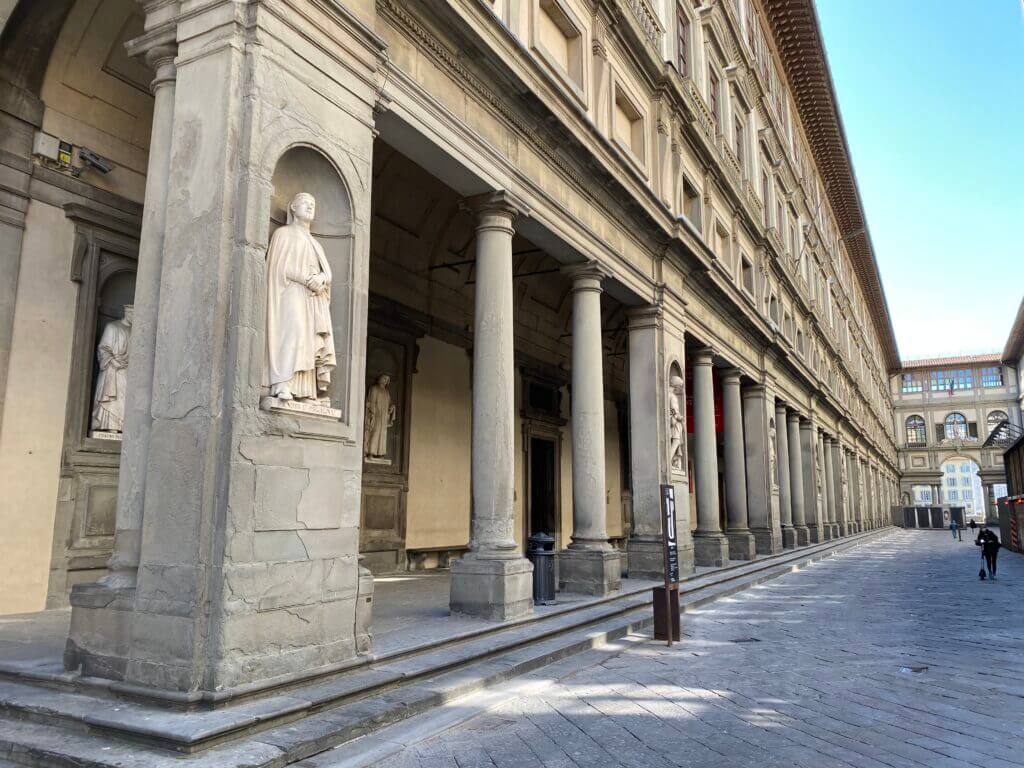Between Ponte Vecchio and Palazzo Pitti, on via de’ Guicciardini, you’ll find Palazzo Dragomanni with its magnificent residences. This part of the historic center is known as the Oltrarno, where you’ll experience the most authentic Florence.
The Oltrarno, or Diladdarno as it is called in Florence, is one of the most beautiful and characteristic neighborhoods in the historic center. It stretches along the southern bank of the river and is crossed by the famous Borgo San Frediano, where you’ll find artisan workshops specializing in art and leather goods. The culinary offerings are diverse, ranging from street food to sophisticated dining with Michelin-starred restaurants. Don’t miss via Maggio, which is the heart of Florence’s antiques district.
In the past centuries, the Oltrarno, where Palazzo Dragomanni is located, became a chic neighborhood where many aristocrats built their palaces and villas, the most significant of which is undoubtedly Palazzo Pitti, once the residence of the Medici during Cosimo I’s era.
Today, Palazzo Pitti hosts many exhibitions and museums, among the most important in the city. Other notable attractions in the Oltrarno include the Brancacci Chapel with its magnificent frescoes by Masaccio and Filippino Lippi, Piazzale Michelangelo with its breathtaking view of Florence, the magnificent Basilica of San Miniato (one of the highest points in the city and the finest example of Romanesque art in Tuscany), and Ponte Vecchio, home to countless jewellers and goldsmiths.
Inside the Palazzo Pitti museum complex is the wonderful Boboli Gardens, an open-air museum of sculptures, some dating back to the 16th and 17th centuries.
Finally, the Oltrarno is also famous for the Santo Spirito market (held every morning), its cafes (such as Ditta Artigianale, Vito Cortese Caffè, Caffè degli Artigiani, Caffè Maioli…), and its trattorias offering Tuscan cuisine (like Cammillo, Il Bordino, Il Santo Bevitore, I 4 Leoni, Osteria del Cinghiale Bianco…). Those who choose to live in this area will find a wide range of food stores, pastry shops, bakeries, and much more.
A city to discover
Florence
Official Ticket Office of the Florentine Civic Museums. Link
Here you will find and can visit the Salone dei Cinquecento, the most emblematic room of the Palazzo. Just as in the time of Cosimo I de’ Medici, it remains the privileged venue for the city’s ceremonies. Link
Acquired in 1550 by Cosimo I de’ Medici and his wife Eleonora of Toledo to transform it into the new grand ducal residence, Palazzo Pitti soon became the symbol of the Medici’s consolidated power over Tuscany. It was also the residence of two other dynasties: the Habsburg-Lorenas, who succeeded the Medici from 1737, and the Savoys, who inhabited it as the kings of Italy from 1865. Link
Behind Palazzo Pitti stretches the wonderful Boboli Gardens. The Medici were the first to arrange it, creating the Italian garden model that became exemplary for many European courts. The vast green area, divided in a regular manner, constitutes a true open-air museum, populated with ancient and Renaissance statues and adorned with grottos and fountains. Link
A masterpiece of Renaissance architecture in Florence and a dynamic international cultural center, Palazzo Strozzi represents a landmark in the Italian scene: a platform for producing and experiencing art through a rich program of exhibitions and cultural activities. A symbolic place for the life of the Palazzo is the historic Renaissance courtyard, an open square to the city where over two million people pass each year and where concerts, performances, and installations by contemporary artists are organized. Link
The remarkable construction of Santa Maria del Fiore, Giotto’s Campanile, and the Baptistery of San Giovanni are artistic masterpieces and at the same time engineering marvels. Brunelleschi’s dome is a wonder: an example of how Renaissance man was capable of exploring new and daring solutions. Link
The Opificio delle Pietre Dure is a special autonomous institute of the Ministry of Culture that operates as a national center of expertise and reference in the field of art conservation, performing restoration, research, and advanced training activities. The Opificio is also home to the Museum of the Artistic Production of Hard Stones and a specialized library. Link
Discover Dante, his life, his work, and his city through the offerings of the Museo Casa di Dante: guided tours for everyone, workshops, and thematic routes from the streets of Florence to the museum’s rooms. Link














